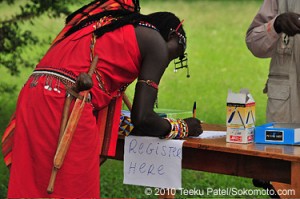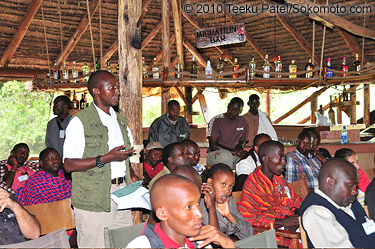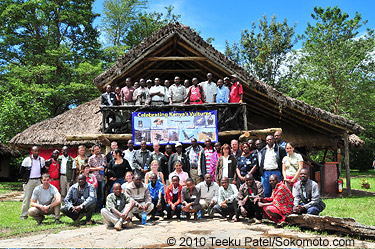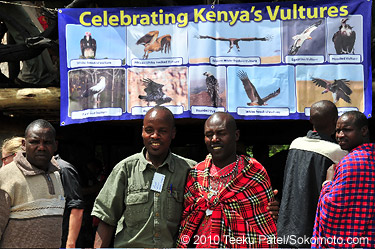Vulture Workshop in the Masai Mara National Reserve – by Munir Virani
 It was quite a frantic week planning ahead for the 3rd Vulture Workshop (the second in the Masai Mara) funded by The Peregrine Fund, which took place at Basecamp Explorer in the heart of the Masai Mara National Reserve in Kenya. The Basecamp Foundation and the Explorer Camp were extremely generous to provide subsidized accommodation while Vintage Africa provided a vehicle for participants attending from Nairobi (National Museums of Kenya, Kenya Wildlife Service, and Nature Kenya’s Raptor Working Group) and neighboring Masai villages. The Masai Mara National Reserve provided free entry to workshop participants.
It was quite a frantic week planning ahead for the 3rd Vulture Workshop (the second in the Masai Mara) funded by The Peregrine Fund, which took place at Basecamp Explorer in the heart of the Masai Mara National Reserve in Kenya. The Basecamp Foundation and the Explorer Camp were extremely generous to provide subsidized accommodation while Vintage Africa provided a vehicle for participants attending from Nairobi (National Museums of Kenya, Kenya Wildlife Service, and Nature Kenya’s Raptor Working Group) and neighboring Masai villages. The Masai Mara National Reserve provided free entry to workshop participants.

My colleagues and I had planned this workshop months ahead with two principal aims in mind – first to update stakeholders of the Masai Mara (park and conservancy managers, community outreach officers, guides, government wildlife custodians, etc) about the latest results our Vulture Project since its inception in 2003. And second, to get community consensus on the directions of future research, initiatives on expanding vulture awareness amongst the Masai community, and to outline a policy to safeguard rapidly declining vulture populations. We were overwhelmed by the interest and enthusiasm displayed by all the participants especially the Masai community who turned out in large numbers. We had close to 60 participants and they came from as far as the Mara North Conservancy, areas at least 60km from where the workshop was held. They included teachers from primary schools, the local Chief, the Kenya Wildlife Service Senior Warden from Narok District, and elders from Masai villages. The ideal settings at Basecamp overlooking the magical Mara plains with a herd of grazing Topi were perfect for the workshop. Participants started trickling in at about 9 am on the morning of the workshop.

Dr Muchai, Head of Zoology, National Museums of Kenya made the opening remarks which was followed by the official opening of the workshop by Mr Kuiyoni, who represented the Chief Park Warden of the Masai Mara National Reserve. Dr Darcy Ogada opened the proceedings by giving a fascinating lecture about vultures and why we need them. Paul Kirui, who was supported by The Peregrine Fund for his Gold Award Certificate followed by giving a presentation about his work on vultures in the Masai Mara and the major threats facing them. Simon Thomsett talked the audience through a gruesome but highly informative video about how he found 187 dead vultures – poisoned by the deadly carbamate pesticide Furadan in 2004. My presentation after the tea break highlighted how vulture populations of all species in Kenya have declined since the mid 1980s and elaborated on the vulture wing-tagging that has helped to raise the profile of vultures in the Masai Mara area plus provided novel information about vulture movements across the Mara-Serengeti ecosystem. Corinne Kendall who is conducting her PhD studies on vultures (Princeton University and National Museums of Kenya) wrapped up the morning session by providing in-depth results of her vulture work in the Masai Mara. By far, her data on vulture movements based on 14 GSM-tagged vultures (basically vultures tagged with miniature cell phones and send her text messages) had the audience captivated. “I cannot believe that these vultures go as far as northern Kenya near Marsabit and as far south in Tanzania,” said an astonished Jonathan Olkumum from Mara North Conservancy. “We have a moral obligation to protect them,” said Wilson Pesi, a naturalist from Ilkeliani Camp, where Corinne is based. The GSM units have been funded by the Hawk Mountain Sanctuary

Immediately after Corinne’s presentation, the skies opened and the rain pelted the grasslands and the camp. Basecamp put on a finger-licking lunch. As I walked around the conference hall, I watched and listened how everyone was engrossed in talking about vultures. “I had no idea that vultures were so critical to the well being of the Masai Mara and wildlife in general,” said Daniel Rutoh, a teacher from Siana Boarding Primary School. “This has given me the opportunity to impart this knowledge to my students” he continued.
In the afternoon, participants broke into three groups to deliberate on aspects of research, education and policy, all with the common goal of ensuring the future survival and conservation of vultures in the Masai Mara. All participants agreed that educating local Masai communities about the need to appreciate vultures would be an important breakthrough in helping to curb poisoning of vultures, predators and other wildlife through retaliatory attacks. Overall, we were extremely pleased with the overwhelming success of the workshop. I am working on a detailed report, which will be made available soon.

I want to particularly thank Corinne Kendall, Darcy Ogada, Simon Thomsett, Paul Kirui, Dickson Ole Kaelo, Teeku Patel, Ashwika Kapur, John Musina, Titus Imboma, Ngaio Richards, Muchai Munane, Peter Njoroge, Seif Abeid, Annette Bulamn, Lars Lindkvist, Azim Rajwani, Jay Sanghavi, Steven Minis, Anne Marie, Mary Kimari, Sospeter Kiambi, Moses Kuiyoni, Simon Nkoitoi, and John Saruni for their help in putting the workshop together. A detailed acknowledgements list will be published in the final report.
This report has been reproduced with kind permission from The Peregrine Fund.





That was an amazing workshop imparting very importance knowledge to community on our vultures.